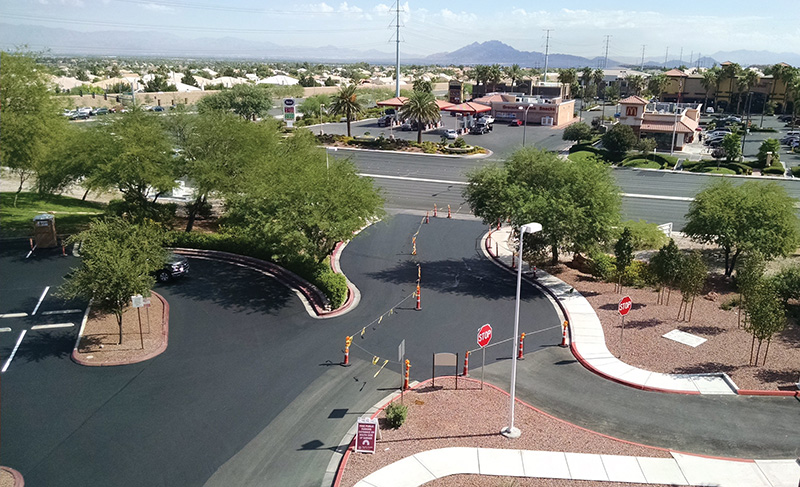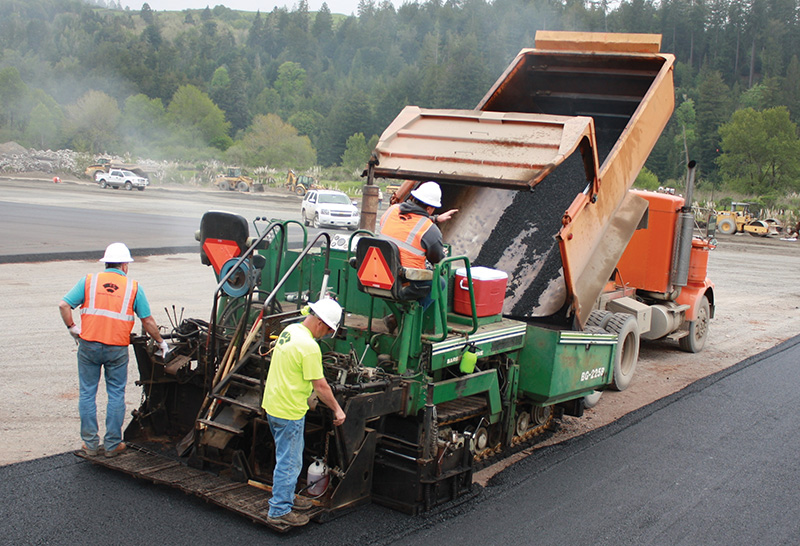Parking lots — a key to your sustainability plan.
By Christie Knable
Sustainability programs have become more important to all levels of business and consumers. A good sustainability program will have implications to society, the environment and the economy. The overarching goal of such a program, research will show, is to demonstrate a responsible approach to decision making and innovation, with attention to how these decisions impact our planet. While some industries require these programs, today’s consumers want to do business with companies that embrace such a culture.
Parking lots can (and should) be a key participant in a company’s sustainability program. A parking lot is a capital asset that requires regular maintenance for optimal appearance, performance and longevity. The maintenance program for a lot can include ways for sustainability goals to be met and good corporate citizenship demonstrated.
 Storm Water Management
Storm Water Management
Storm water runoff is simply the rainwater or snowmelt running off a lot. It flows from the lot through properly installed and well maintained drainage in a way that is not detrimental to the environment. Poorly installed and/or maintained drains can be in violation of protective environmental regulations; but poor storm water management will also cause expensive damage to a lot as well as create unsafe conditions. A professional parking lot management partner should have a clear understanding of how storm water drainage impacts the environment as well as the integrity of the lot and apply this knowledge in developing a realistic maintenance plan that will support local and national standards and regulations. The result is a functional and safe lot. There are now materials, such as pervious asphalt and concrete, which allow storm water to drain through the surface versus being funneled through to a storm drain.
Sealcoating
A number of factors can negatively affect the look and color of an asphalt surface. These contributors include weather, chemicals from vehicles, and heavy equipment usage. A great way to give a lot a facelift is by applying a sealcoat. This important maintenance activity will not only give it a fresh new look but will ultimately extend the life of the lot by preventing water seepage from undermining the subgrade. Preventing water seepage and encouraging proper drainage are critical to maximizing the life of an asphalt lot. The product can be asphalt-based, a refined tar, or could even include filler such as small chips. A site visit will help the installer understand many aspects of the lot from areas of erosion that will require patching to traffic patterns that will need to be adjusted to storm drains that should be blocked during application. Sealcoat should not be applied if rain is forecasted within 24 hours to prevent the uncured product from washing off. A properly sealed lot will have a longer life, and provide a smooth and safe parking, driving and walking surface. An annual application of sealcoat, which supports sustainability initiatives through cost avoidance for most costly repaving, is environmentally responsible when properly applied and provides a safe and functional parking lot for clients, employees and vendors.
Overlay
When a lot shows severe deterioration with deep cracks and many potholes, a good choice is to overlay. Overlay is a method of repaving and involves applying a layer of asphalt compacted to about 2 inches directly on top of the existing surface. Areas that have total failure to the base level supporting the pavement will require removal and patching prior to the overlay. A good choice of asphalt with sustainability in mind is warm asphalt — a product that requires less heat to mix and includes recycled materials. An overlay will breathe new life into a lot with extreme wear. Correcting failed surfaces with a properly installed overlay of warm asphalt is a responsible way to extend the life of a lot.
 Full Replacement
Full Replacement
Parking lot surfaces do not last forever and there comes a time when a lot simply needs to be replaced. Complete replacement will be recommended when one-third of the lot has failed. A full depth reclamation involves removing the asphalt and some of the base materials and pulverizing them into tiny pieces. These pieces are used as aggregate for the new lot — thus eliminating the need for old materials to be trucked to a landfill. This process of incorporating the existing parking lot materials into the new surface is what makes asphalt the Number 1 recycled product in America. The use of warm asphalt from a nearby plant is yet another way a provider can install a new lot with sustainable practices. This is also an opportunity for introducing more green space to a lot, such as adding trees for natural shading. These choices not only benefit the environment but also enhance the aesthetic quality of a fresh lot. An engineer will ensure the base is stable, drainage is correct, and any new features are properly added before the fresh surface is paved when a full replacement is required.
Striping
The proper application of striping is essential for a safe lot. The application can include a variety of methods from the use of global position systems to stencils. No matter the method or equipment used, a well striped parking lot creates a set number of parking spaces on a lot. One school of thought for increased sustainability is reducing the size of the spaces — thus increasing the total number of spaces or creating space for new features such as more trees for natural shading. A parking lot management’s engineering team can help create new striping options after the application of sealcoat or new asphalt that can support a sustainability plan.
ADA Compliance
The Americans with Disabilities Act (ADA) of 1990 and subsequent revisions ensure, among other things, that all persons will be provided accessible accommodations when entering, exiting and parking at facilities. Meeting both federal and state ADA requirements with regards to parking and entry ways demonstrates good corporate citizenship and employee inclusion. It is a cost avoidance for penalties and fines. A good parking lot management provider will identify risks and gaps in a lot’s compliance and recommend changes needed to bring a lot into alignment with the current federal and local standards.
As you look at the sustainability goals for your company, don’t forget to look at your parking lot as a means of reaching those goals. Fuel usage, liquid asphalt production, hot mix production and long distance trucking of materials each produce unfavorable effects on the environment. Working with the right management company that understands regulations, materials, the proximity of necessary resources and employs sustainability practices of its own will help you get there.
— Christie Knable is vice president of marketing for KAI Total Pavement Management, a nationwide parking lot management company headquartered in Kansas, with field offices nationwide. KAI Total Pavement Management is a division of Kansas Asphalt, Inc. Email [email protected].
